Klima Biennale Wien
2024
05.04. – 14.07.


© Photo: La balada de las sirenas secas, 2020 (c) Patricia Domínguez
Songs for the Changing Seasons brings together an international group of artists to reflect on the myriad ways, at once concrete and poetic, in which art is addressing the realities, effects and consequences of planetary transformation. Songs for the Changing Seasons considers forms of love, attention, repair and grief that meet with ecological challenges and damages. Assuming environmental transformation as a reality, the exhibition looks at where, when and how trouble is felt and expressed, and how art offers vital ways to articulate, interpret and cope with this trouble.
The memory of the world is held by the world itself and retold in human and non-human songs. In what ways is change expressed through and with the bodies of all beings: human, animal, plant and mineral? How are grief and pain, but also hopes, dreams and desires, experienced, processed and imagined on an individual and collective level?
Does the world end when a world ends? History would appear to suggest it does not: worlds end, worlds begin again, and culture encodes the signals of bygone times into the future: epic poems holding the memory of major environmental events, rituals holding long-standing learnings from agricultural practice... Yet the continuity of the world is necessarily told from the perspective of all those who endured beyond endings, conflicts or collapses—while other experiences have been systematically silenced or forgotten.
Reflecting on how ecological concerns are felt and dealt with through art, the exhibition focuses on the rhythms, repetitions and also endings that mark the ebbs and flows of our planet.
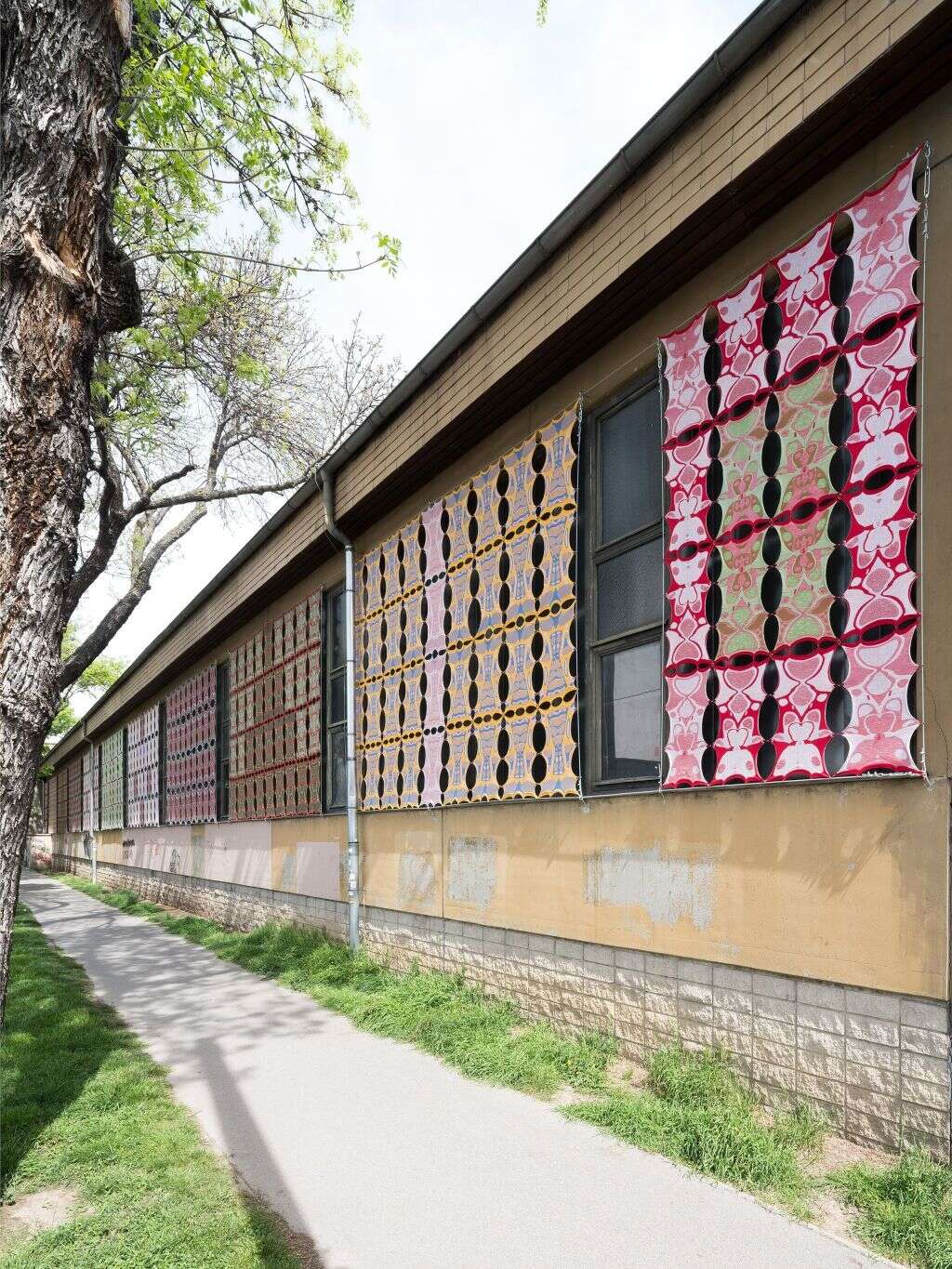
Yussef Agbo-Ola/Olaniyi Studio. 12 Claws in Cloud Dust: Air Altar (c) Rudolf Strobl / Klima Biennale Wien
Born in rural Virginia in a multi-heritage Nigerian, African American and Cherokee household, artist and medicinal architect Yussef Agbo-Ola is the founder and creative director at Olaniyi Studio, based in London. Agbo-Ola’s multidisciplinary practice focuses on interpreting natural energy systems through interactive experiments that explore the connections between the biological and anthropological, the perceptual and microscopic. These themes reflect hybrid identities and relationships to different landscapes, ecologies and cultural rituals. He uses multidisciplinary research methods and design components to reinterpret local knowledge and its environmental importance cross-culturally. His research outcomes manifest through living architectural temples, material alchemy, interactive performance, experimental sound design and conceptual writing.
For Songs for the Changing Seasons, Yussef Agbo-Ola created his first ever architectural/installation hybrid conceived for an outdoor space. 12 Claws in Cloud
Dust brings Agbo-Ola’s characteristic juxtaposition of a metal support
structure with bespoke stretched fabric that fills in the structure.
The fabric reproduces several insect species at risk of extinction. The
exterior structure is aligned to the windows of the Nordwestbahnhof halls and creates an interplay of shadows that modulates the
atmosphere of the interior environments. Agbo-Ola has often talked
about his artistic and architectural interventions as spaces for contemplation or ritual—as temples for reflection on our entanglements
with more-than-humans. The structure figures as an ode to the possibility of regret and regeneration so that while it greets visitors upon
arrival, it is also a consecration homage to representatives of the
astounding diversity and creativity of the planet.
Yussef Agbo-Ola / Olaniyi Studio
12 Claws in Cloud Dust: Air Altar (2024)
Cloth, steel wire frames, dimensions variable
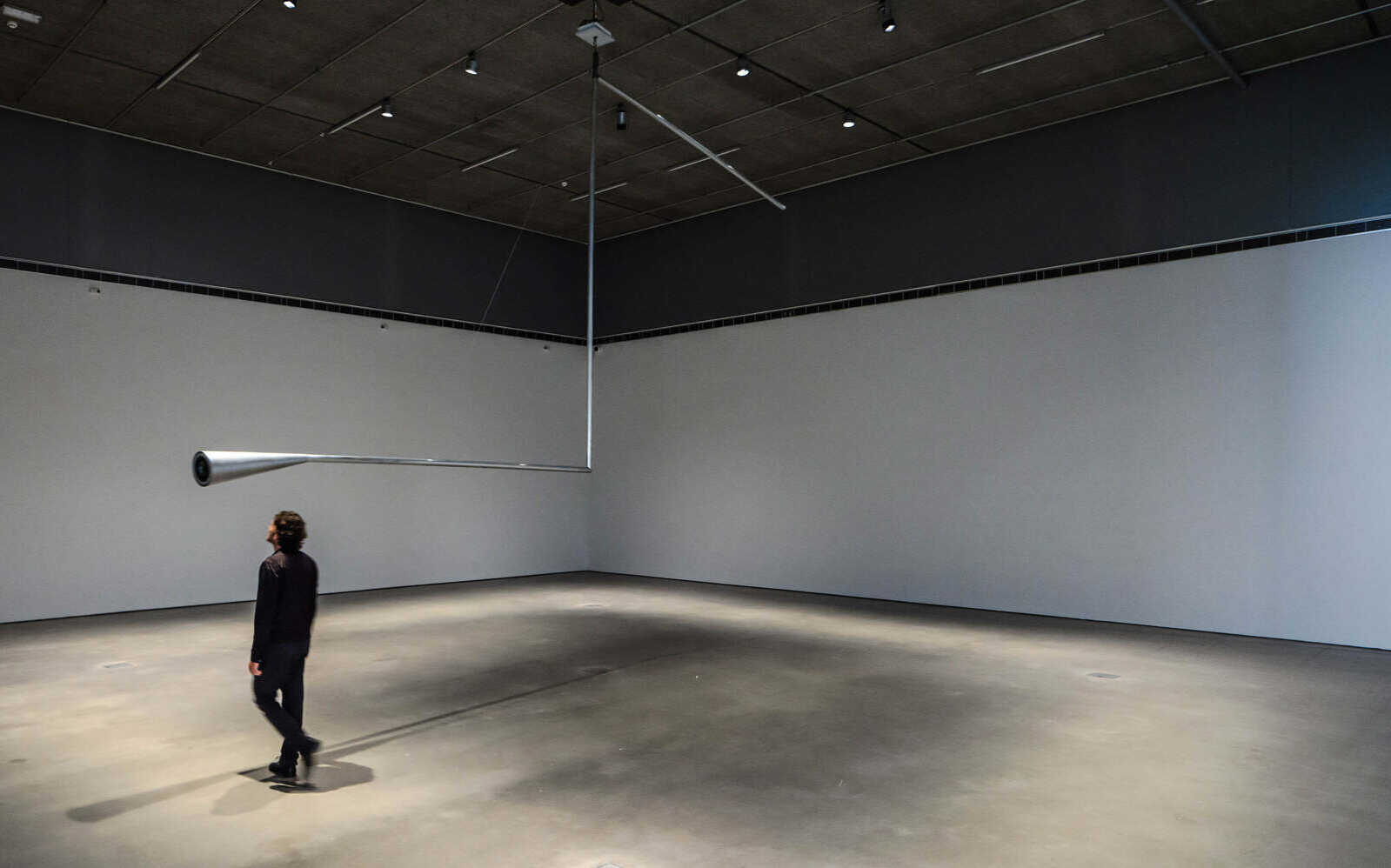
Cooking Sections. Salmon Feed Chains 2022 (c) Courtesy of the artists
Cooking Sections examine the systems that organise the world through food. Using site-responsive installation, performance and video, they explore the overlapping boundaries between art, architecture, ecology and geopolitics. Established in London in 2013 by Daniel Fernández Pascual and Alon Schwabe, their practice uses food as a lens and a tool to observe landscapes in transformation.
In 2015, they initiated CLIMAVORE, a research-driven project that seeks to reimagine, through artistic interventions, the possibility to transform food systems, policy, infrastructure and culture. In a climate-disrupted, heavily industrialised landscape, CLIMAVORE offers an adaptive diet that looks at the upstream effects of food consumption as an opportunity to adapt to disrupted seasons, inserting regenerative and reparative interventions into the food chain. CLIMAVORE was initiated on the Isle of Skye, Scotland, where industrial salmon farming is causing devastating effects on the local ecosystems, from chemicals released into the water to how artificial salmon-colouring feed is turning all kinds of species salmon. Salmon: Feed Chains invites audiences to walk in circles to experience an audio piece that reproduces the infinite, circular movement of farmed salmon, whose life is trapped in a circular cage in polluted waters.
Cooking Sections
Salmon: Feed Chains (2022)
Performative installation, 20 min.
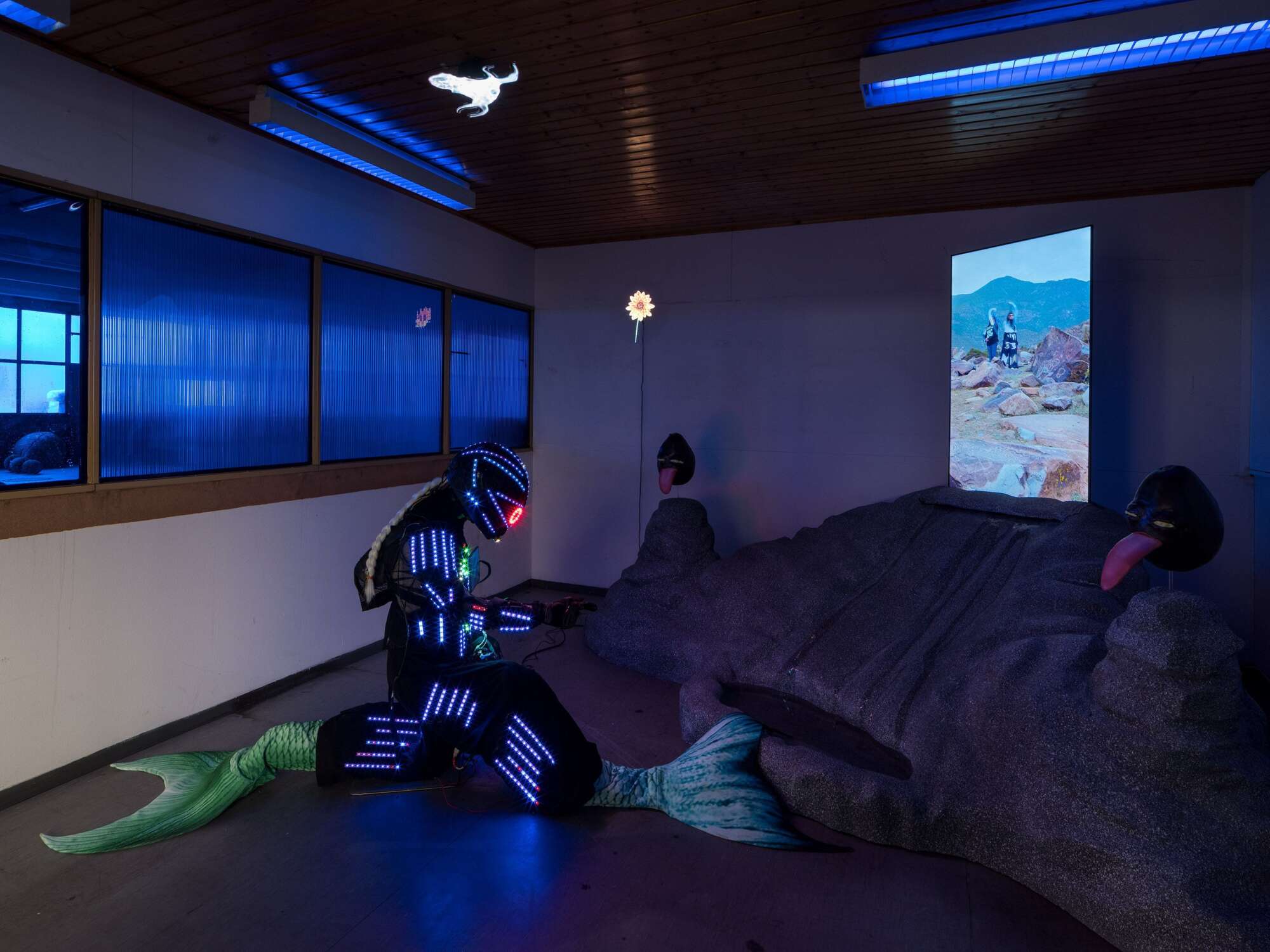
Patricia Domínguez. La Balada de las Sirenas Secas (c) Rudolf Strobl / Klima Biennale Wien
An Earth defender based in Puchuncaví, Chile, artist Patricia
Domínguez is the founder of Studio Vegetalista, an experimental platform for ethnobotanical research. Her installations take the form of
sculptures, videos and publications conceived to exorcise the effects
of late capitalism on ecology while exploring artistic imagination as
a form of psychic emancipation and a path to heal colonial trauma.
In Chile, a large part of fresh water is privatised, causing a humanitarian crisis in areas damaged by the agroindustry of avocados and citruses. La Balada de las Sirenas Secas [The Ballad of the Dry Sirens] deals with the crisis of water privatisation. The artist collaborated with Rodrigo Mundaca, the national spokesperson for the Movement for the defense of access to water MODATIMA; “Las Viudas del Agua” [the Widows of the Water], a group of women defending water in the Petorca area; and Mr. Juan López, a “singer to the divine” who lives in one of the areas most affected by the crisis, Palquico, surrounded by hundreds of cattle who died of thirst. He has modified the traditional song of the divine to mourn the drought and anguish of the peasants.
The work is inspired by the Mayan codex Tro Cortesiano, housed in the Museo de las Américas in Madrid—it is a gesture of activation of an object detained by a Western museum under an obsolete colonial logic. One of the four surviving Mayan codices, the Tro Cortesiano documents rituals of divination and speculation with waters in relation to planting schedules. Shot during the pandemic, the video documents the water hoarding pools of corporate companies. It depicts an avocado plantation that has been cut down to prevent their death during the megadrought of the Petorca region while updating El Pedernal pre-Columbian petroglyphs with images that recall the watery past of the dry river.
Patricia Domínguez
La Balada de las Sirenas Secas (2020)
Installation with Styrofoam mountain cascade,
fiberglass, electrical water circuit,
LED suit with mermaid tails,
3D-printed sculptures, holographic projections,
video on monitor, 31:54 min. Courtesy of TBA21 Thyssen-Bornemisza Art
Contemporary Collection

Eva Fàbregas. Exudates (c) Rudolf Strobl / Klima Biennale Wien
Working with soft and malleable materials, the practice of Barcelona- born and based artist Eva Fàbregas embraces tactile engagement, physical intimacy, sensorial relations and multiple forms of somatic experimentation with and through objects. She considers touch as a primary source of knowledge. Her work belongs to the realm of the somatic, the experiential, the guttural and the unnamable. It aims to fully inhabit the world of the senses, invoking a pre-linguistic stage to imagine other possible bodies, other ways of feeling, caring and being in the world.
Exudates, her new series, presents a new step in the artist’s on-
going work with haptic visions and sensorial encounters. With darker,
yet still bodily colours, her sculptures appear in purples, browns,
rusts and copper tones. They are now wrinkled, with small and large
folds that resemble the ways the skin and organs respond to tension
and release. Arranged as various sets that are distributed around
the space of the Nordwestbahnhof, the forms appear and reappear
throughout the whole exhibition space. Exudates constitute a multitude of corporeal entities where the human, the nonhuman and the
posthuman challenge their own boundaries, definitions and forms
Eva Fàbregas
Exudates (2024)
Air, latex, elastic fabric, inflatable balls,
variable dimensions
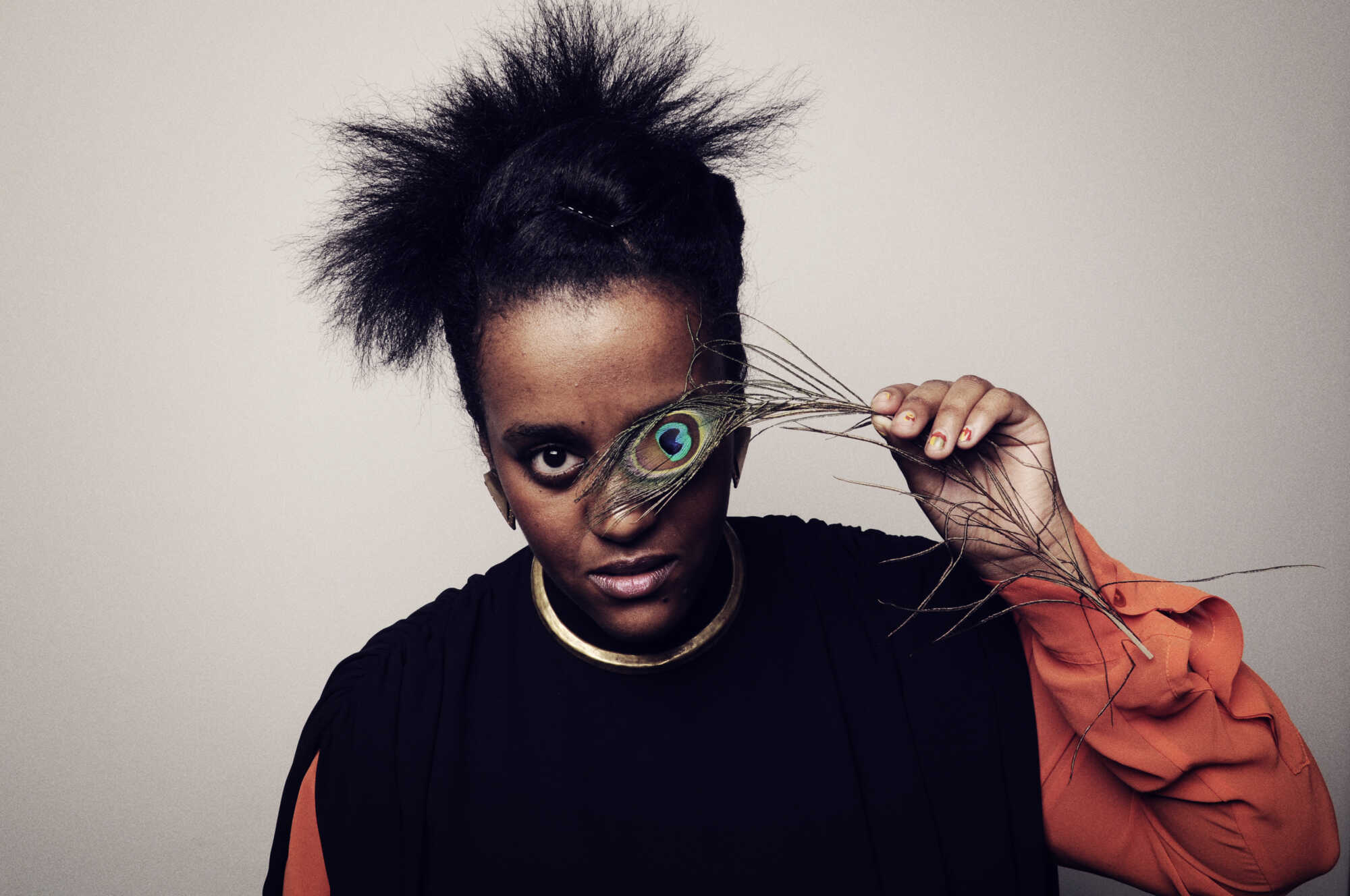
Sofia Jernberg (c) Jon Edergren
Sofia Jernberg is an experimental singer and composer born in Ethiopia and living in Stockholm. Her work focuses on unconventional techniques and sounds such as non-verbal vocalisation, split tones, toneless singing and distortion. She has received several commissions for compositions and recently premiered Dreams of our Future for children’s choir, soprano, voice and chamber ensemble at the Ultima Festival Oslo 2022 and a new composition for the Ensemble Contrechamps at the Borealis Festival 2023 in Bergen.
Songs for the Changing Seasons, the new sound work commissioned for the exhibition, welcomes visitors through the hall leading
to the Papageienhalle, where the exhibition takes place. The piece
expresses how human presence enforces itself on the Earth, manifested through a sonic dialogue between human and animal sounds.
It ends with an almost inhuman tone, with a penetrating high whistle
pitch emitted in a cave close to the ocean, were water dripping from
the roof of cave, the wind and ocean waves can be heard
Sofia Jernberg
Songs for the Changing Seasons (2024)
Sound installation, 20 min.
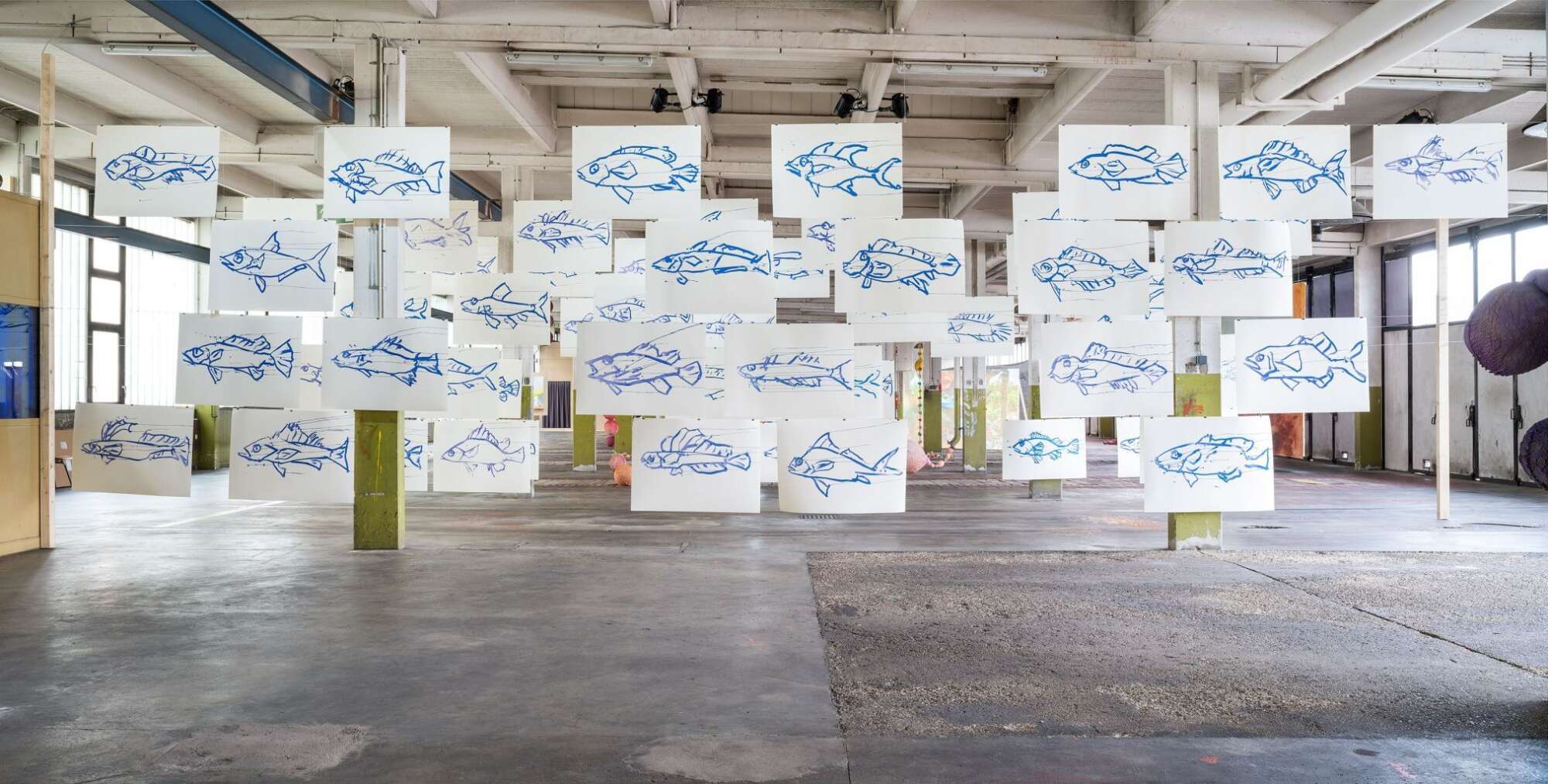
Joan Jonas. They come to us without a word II (c) Rudolf Strobl / Klima Biennale Wien
For over five decades, New York-born and based artist Joan Jonas has been contributing to define contemporary art in its disciplinary elasticity. Through her performances (often involving her own presence), drawings (mostly of animals), sculptures (often with abstract, geometric references), environments and video installations (further including objects, props and complex display systems), the artist dilutes the separation between a video and a drawing, a gesture and a dance, a song and a myth, the writing of history and the telling of a story. Her interest in nature turned her into an essential voice for our times of ecological unrest.
they came to us without a word II was originally made for the homonymous exhibition at the Centre for Contemporary Art Kitakyushu, Japan, in 2013. The large series of blue fish drawings celebrates these creatures while alluding to how oceans are being emptied out of the life they foster. The CCA Kitakyushu exhibition was the first time that Jonas publicly incorporated her concerns for the endangered state of the ocean in her work. On that occasion, she made a series of more than 100 fish drawings inspired by Toshiji Kamohara’s 1955 book Coloured Illustrations of the Fishes in Japan, which she had found in a second-hand shop. These fish, she argued, also stood for the excessive consumption of fish in Japan and the world. Such worries are visible in how each fish is an individual, with unique features, a testimony to Jonas’s outstanding mode of drawing and painting animals. The fragility and mobility of the paper sheets in which each fish is painted expresses their uniqueness and vulnerability. Presented as a large school of fish, the assemblage gives a sense of a poetic prosperity that mourns the depletion of the seas.
Joan Jonas
they come to us without a word II (2013–23)
68 exhibition copies of ink drawings on paper,
variable dimensions
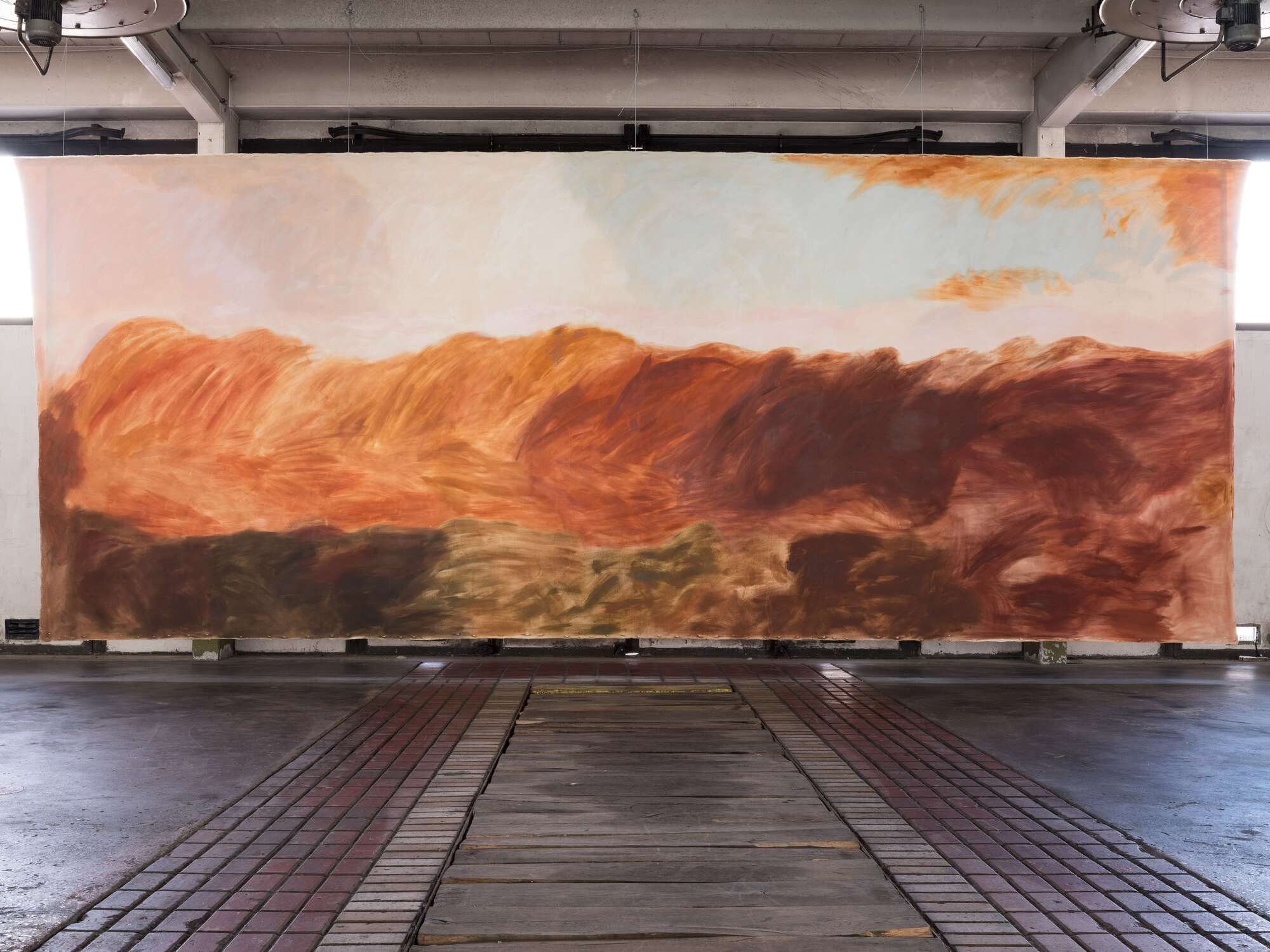
Dominique Knowles. Morning Pasture (c) Rudolf Strobl / Klima Biennale Wien
Bahamas-born, Paris-based artist Dominique Knowles makes large-scale colour-field works that oscillate between abstraction and figuration, compounding genres into a poetic configuration of light and shadow. An avid equestrian from an early age, Knowles creates intimate and ethical spaces for his animals to live in. The process is a meditation for the artist, and he likens the gestures of mark-making to brushing a horse in the grooming process. He works with luminosity, which reveals or obscures the figure, having grown up in a country where light scintillates and coexists with the densest shade of black.
Dominique Knowles’ large oil on canvas Morning Pasture takes viewers back and forth in time: traces of the first landscapes ever made relate to the post-anthropogenic lands of the current deranged times. The landscape appears as a series of abstract, entangled masses, flexible and folded within themselves, poetically alluding to the rhythms and flows of co-creation of the natural world that reverberate with Knowles’ own words: “I long for the chance to realign in new memories of queer sensuality [...] I am a Centaur, fertile with another creature.”
Dominique Knowles
Morning Pasture (2020)
Oil on canvas, 304.8×762 cm
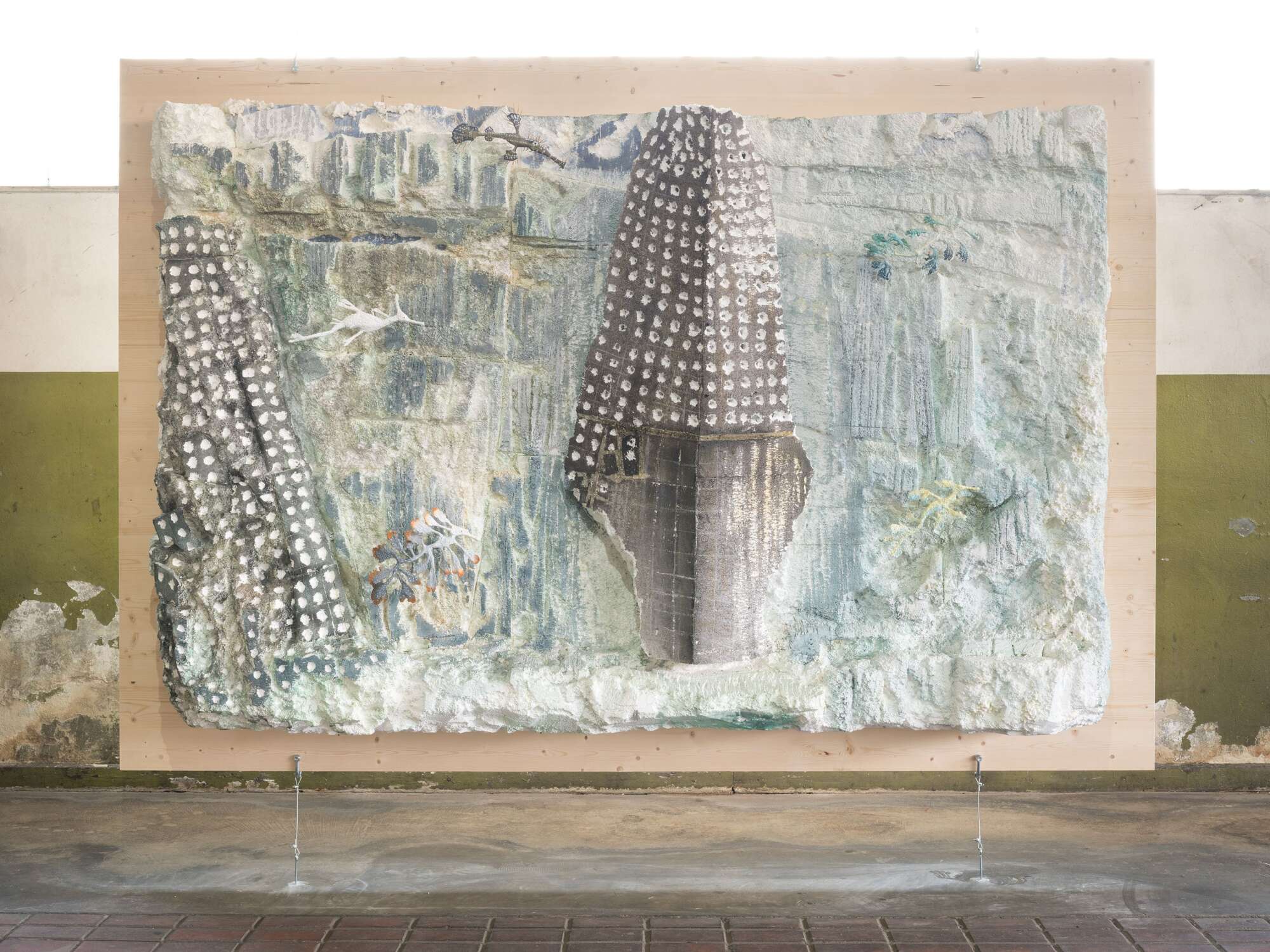
Lin May Saeed. Sea Dragon Relief (c) Rudolf Strobl / Klima Biennale Wien
“I am a sculptor who explores the human-animal relationship. My perspective on this subject influences my artistic practice, which is fundamentally conceptual. My way of working in the studio is pre- dominantly affective and processual. From the beginning, I was influenced by conversations with animal liberation activists, by a study of animal rights literature and current debates on the topic. [...] I discovered Styrofoam as a material for my artistic practice in college. The fact that Styrofoam is a (hu)man-made petroleum-based plastic seemed to make sense because it says something about the present. Since I work figuratively, life-size was important so that the viewer is at eye level with an animal or human figure. The light weight of the material makes it possible to work on a larger scale. About half of the material I use, I get from construction sites or from leftovers. [...] There is an additional reason why I like working with Styrofoam. Most animals have fur, feathers, scales or an exoskeleton, and depicting that sculpturally is a challenge. Every living thing moves almost constantly, and motion blur and vividness go together. Likewise, there is a blurriness when working with Styrofoam because of the materiality. Styrofoam is, first of all, block material and on closer inspection it has a smallest visible unit, namely small spheres. The fact that the naked eye can see the smallest unit has a poetic quality. I like to imagine that they are atoms. I look for the productive interplay of these two blurs, the granularity of the material and the living things that emerge from it. And perhaps most crucially: I understand my works not as objects, but as subjects.”
—Lin May Saeed
Through a consistent formal language, a profound ethical stance, a broad knowledge of fables and history and with humour, the work of the late German artist Lin May Saeed narrates the subjugation and liberation of animals, creating a new iconography of interspecies solidarity.
Lin May Saeed
Bee Relief/The Liberation of Animals from
their Cages VII (2008)
Styrofoam, acrylic paint, steel, transparent paper, wood, 108×143.5×18.5 cm
Sea Dragon Relief (2021)
Styrofoam, steel, acrylic paint, wood, 173×268×51.5 cm
Courtesy of Collection Silvia Fiorucci, Monaco
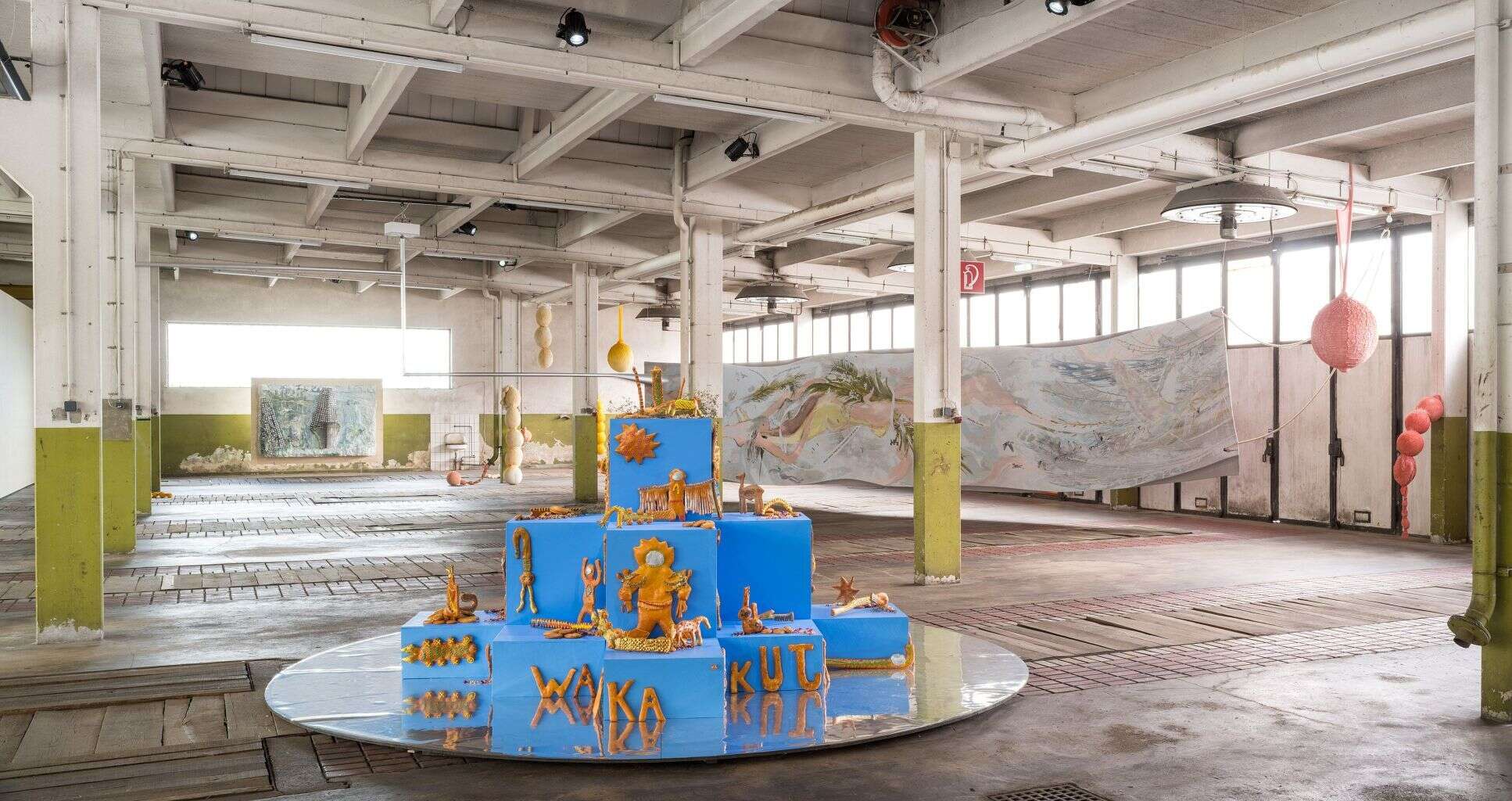
Natalia Montoya. Ajayu (c) Rudolf Strobl / Klima Biennale Wien
Natalia Montoya lives and works between her hometown of Iquique, where she was born, and Santiago de Chile. She is a pilgrim of La Tirana, by family tradition. Her work develops from material concerns, ques- tioning her affective knots to the territories of Iquique and La Tirana, in the Tarapacá region. From there, she extracts materials linked to her imaginary, such as fabrics, sequins and light construction materials.
For her first exhibition outside of Chile, Montoya presents Ajayu, a word that means soul or spirit in the Aymara language, spoken by Aymara communities across the Bolivian, Peruvian and Chilean Andes. Ajayu is the outcome of a short residency in Vienna through a collaboration with the local bakery Ströck. The celebratory and spiritual forms that Montoya made in bread bring together the Andean funerary breadmaking technique of the T’anta wawa (small decorated, human-like bread sculptures) with ancient practices and the imaginary of the alpine regions. Amidst these figures, she will also write the Aymara sentence Waranka Waranka Kujtasiñani [We Will Return in Millions], which is used up to the present day in Andean struggles.
Natalia Montoya
Ajayu (2024)
Flour dough, flowers, food pigment, wooden board,
PVC pavement, variable dimensions
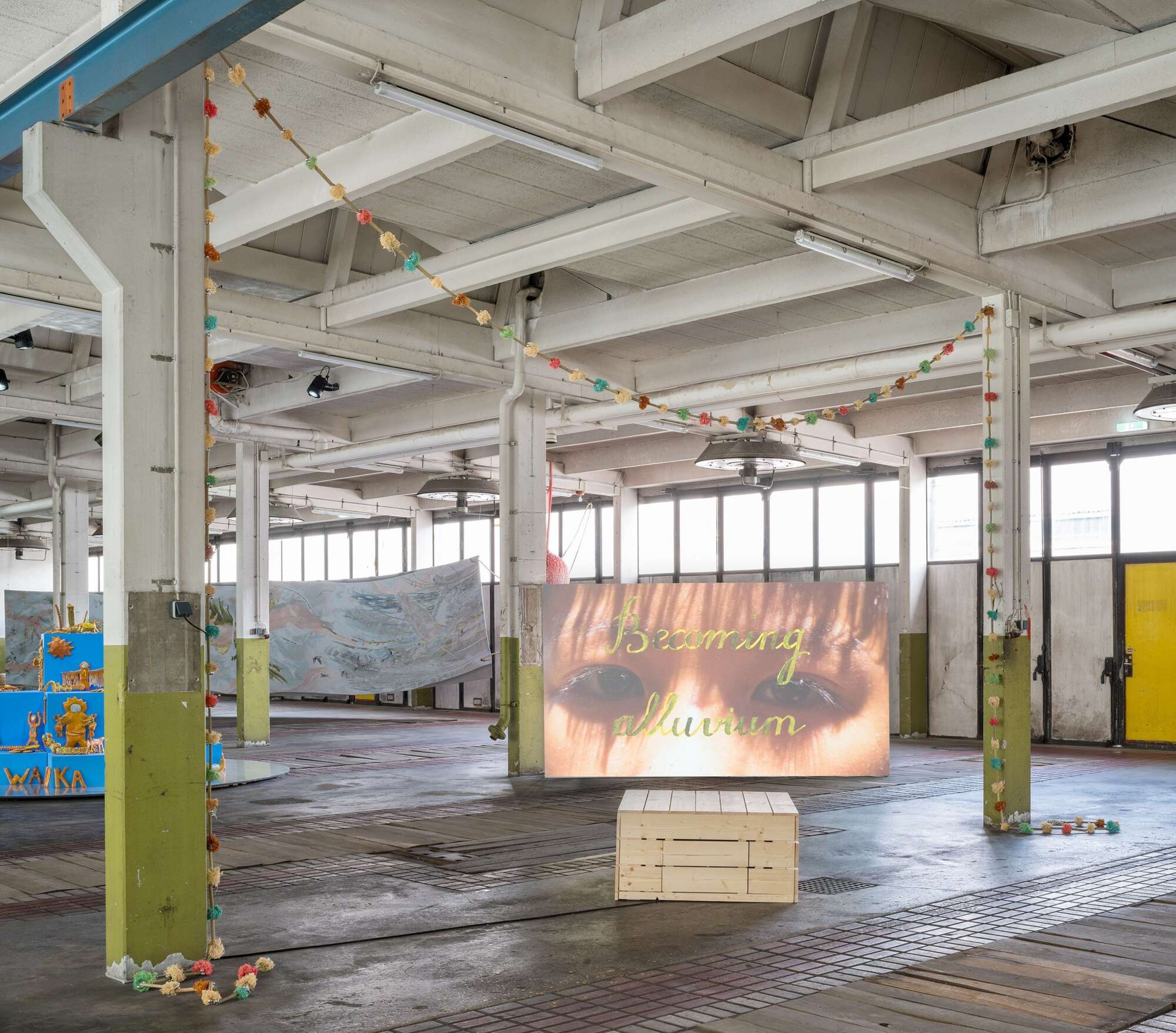
Thao Nguyen Phan. Becoming Alluvium & Ode to the Margins (c) Rudolf Strobl / Klima Biennale Wien
Trained as a painter, Thao Nguyen Phan was born in Ho Chi Minh City, where she lives. She is a multimedia artist whose practice encom- passes video, painting and installation. Drawing from literature, phi- losophy and daily life, Phan observes ambiguous issues in social conventions, nature and history, which she conveys through drawing, storytelling and the creation and exhibition of found and created objects.
Becoming Alluvium is a moving image—as the artist calls all her filmic works—that narrates the naturecultural history of the Mekong River across recollections, legends and representations. In it, the artist brings together fact and fiction, documentation and portrait, ecology and mythology, materials and narratives that concern human and wild lives to address the context of her homeland in Vietnam while echoing wider systems and ecosystems. Articulated in three chapters, Becoming Alluvium narrates episodes of destruction, reincarnation and renewal that take place in and around the Mekong River and the life it fosters. Accompanying it, Ode to the Margins is a specifically commissioned, handmade work that responds to the social, political and natureculture of the Vietnam Central Highlands. The bamboo wreath was originally produced as a Christmas decoration in the Saint Mary’s Cathedral in Kon Tum province, central highland of Vietnam. The cathedral was constructed entirely in wood in a mixture of gothic and vernacular style and was completed in 1918. Since its inauguration, the church has been the main worship site for the Bana Indigenous community and various ethnic groups in the area. In the gallery, the bamboo thread is hung as a wall piece, suggesting how local material such as bamboo and Indigenous craftsmanship, initially used for pagan rituals and traditional ceremonies had been adopted and translated into a new language in support of the new faith.
Thao Nguyen Phan
Becoming Alluvium (2019)
Video HD, 16:40 min.
Produced by the Han Nefkens Foundation
Ode to the Margins (2024)
Bamboo wreath, bells, variable dimensions
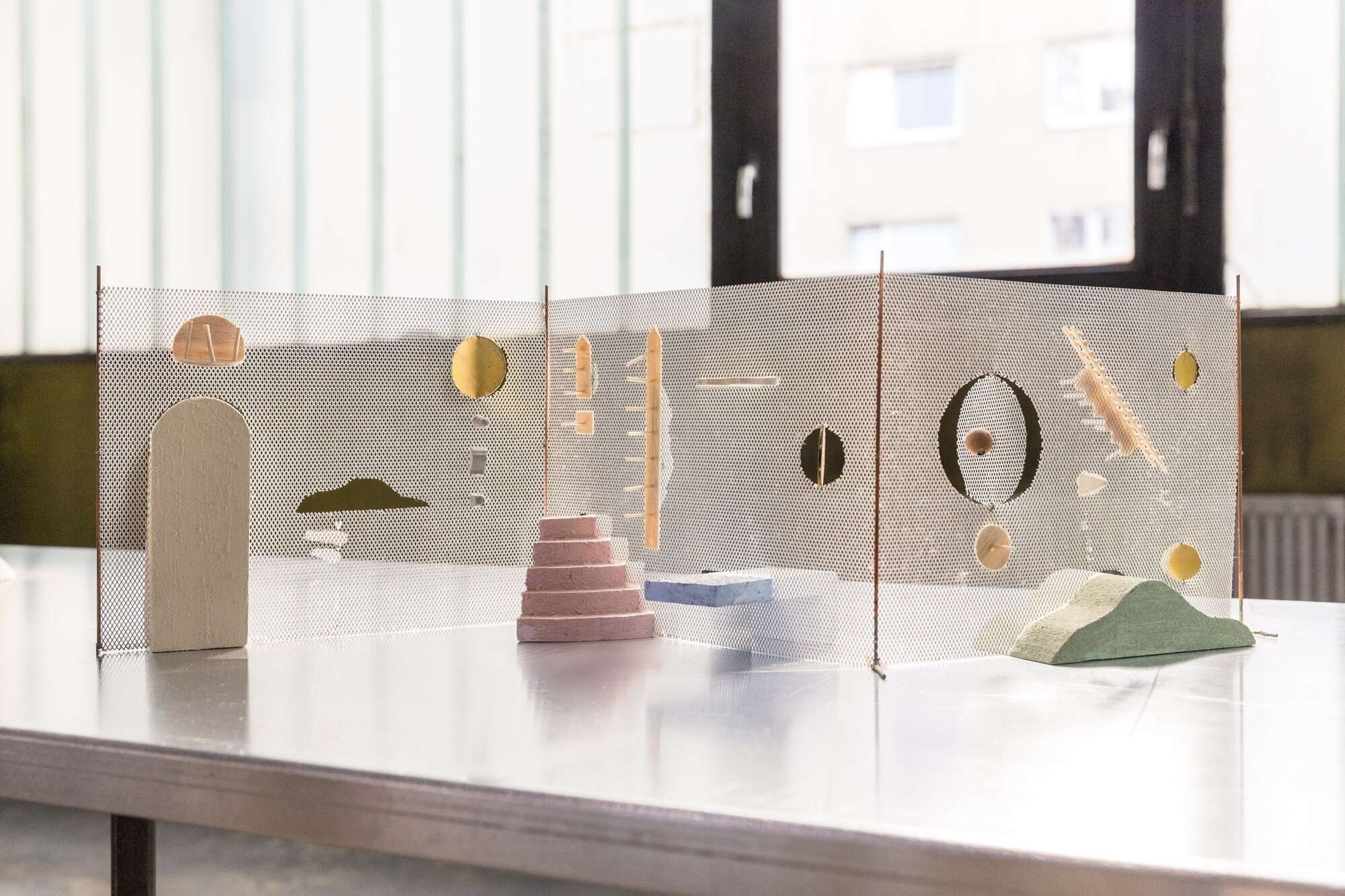
Studio Ossidiana. The City of Birds (c) Rudolf Strobl / Klima Biennale Wien
Founded in 2015, Studio Ossidiana is an architecture and design practice based in Rotterdam, working on materials, buildings, installations, and objects. Studio Ossidiana’s The City of Birds combines interpretations of existing architectural types and tools—pigeon lofts, bat towers, aviaries, parrot perches, bird feeders and traps—with proposals for new mediative objects and spaces. The collection of models looks at the complex, contradictory relationship humans entertain with other animals, and at the importance of contextual, sentimental and aesthetic scales to accompany any quantitative understandings of our relations with the environment.
The goal is to express a gradient of relation between bodies and species: while the cage oscillates between the tender and the coercive, the ironic and the dramatic, the metaphorical and the caloric, Ossidiana see habits transforming into habitats, actions into rituals, earthly practices ascending to metaphors and forms of communica- tion, of which the “cage” is the physical vocabulary.
Studio Ossidiana
The City of Birds (2020-21)
Models, coated aluminum, MDF plates, steel,
variable dimensions
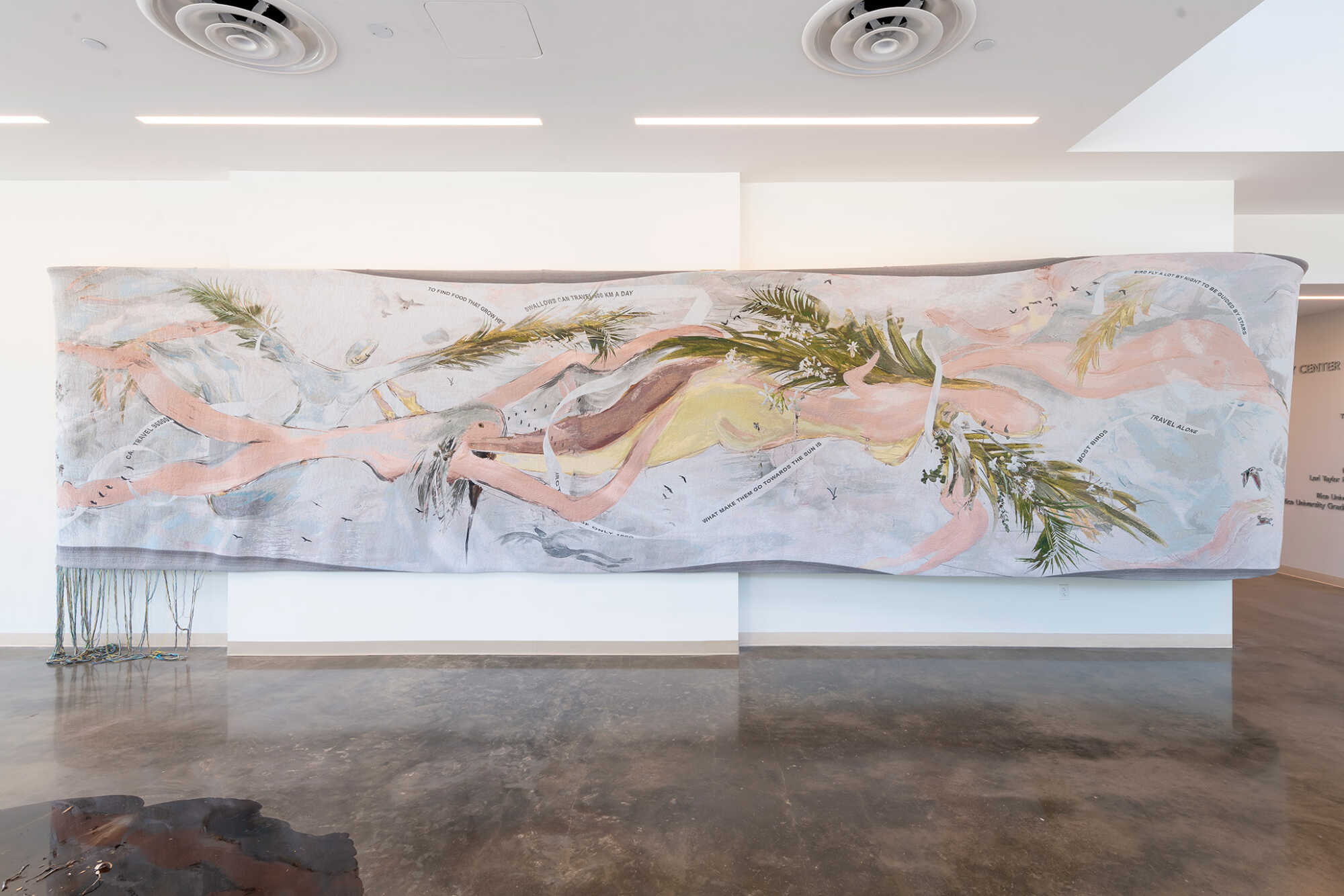
Laure Prouvost. Flying Mother (The Bird Ban Her) Part 2, 2022 (c) courtesy Moody Art Center, Texas & Anthony Rathbun
Language—in its broadest sense—permeates the video, sound, installation and performance work of Laure Prouvost. Known for her immersive and mixed-media interventions that combine film and installation in humorous and idiosyncratic ways, Prouvost’s work addresses miscommunication and ideas becoming lost in translation. Prouvost is interested in confounding linear narratives and expected associations among words, images and meaning. She combines existing and imagined personal memories with artistic and literary references to create complex film installations that muddy the distinction between fiction and reality. She was born in France and is based in Brussels.
The large wool tapestry with hand-sewn individual threads, Flying Mother (The Bird Ban Her) connects bird migration, air and weightlessness with a sense of nurture and sensuous, archetypal femininity. Guiding visitors along a frieze-like narrative, the work demonstrates continuity rather than disconnection between humans and non-humans, suggesting that communication, devotion and responsibility precede and exceed the possibilities of symbolic language. Nevertheless, as bird migration routes are increasingly disrupted by the effects of anthropogenic climate change, a melancholia settles, as we part from the tapestry with the words “most birds travel alone.”
Laure Prouvost
Flying Mother (The Bird Ban Her) Part 2 (2022)
Wool tapestry, 1300×220 cm
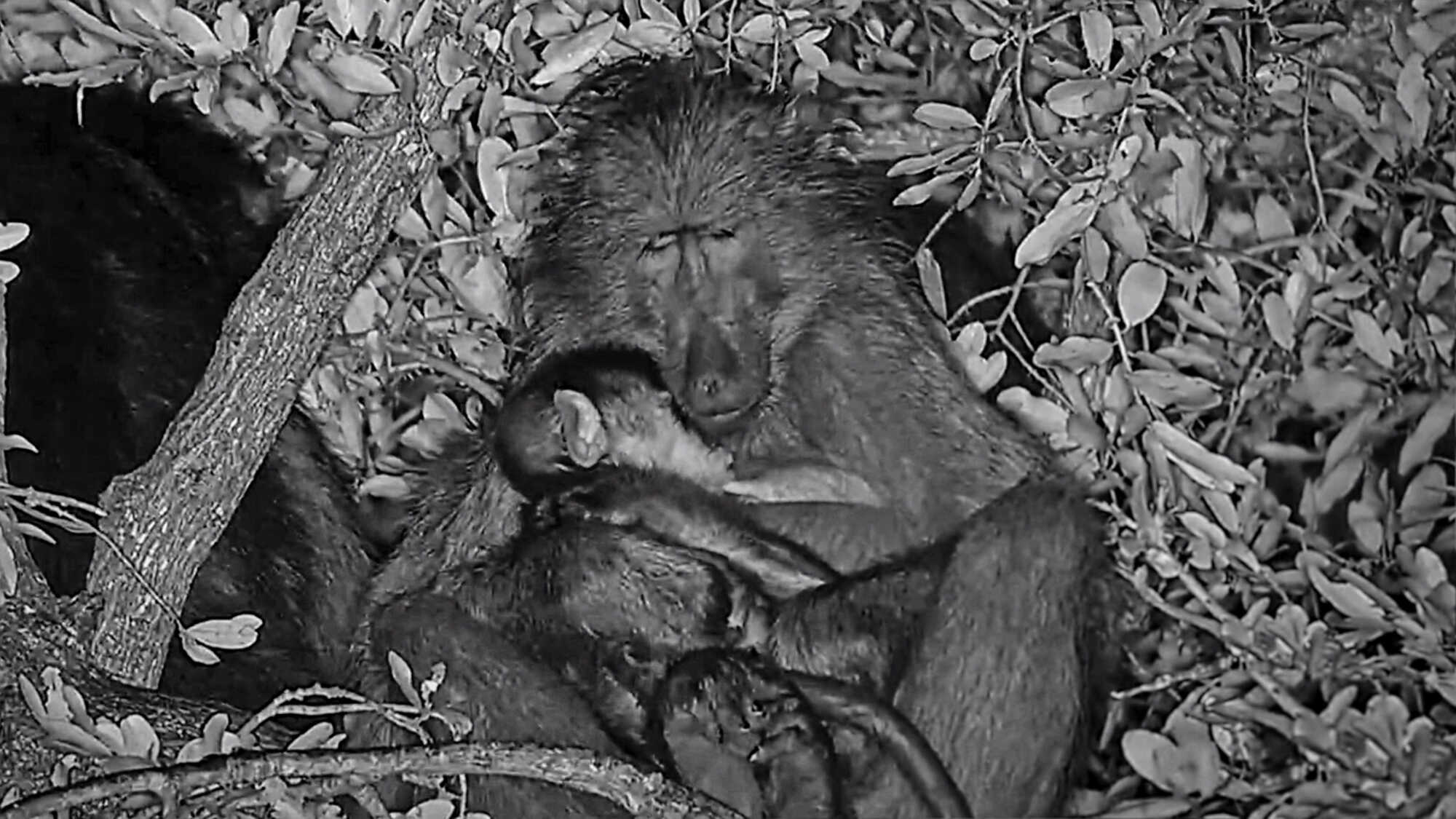
The End of Imagination, 2021 (c) Adrián Villar Rojas
Adrián Villar Rojas conceives long-term projects, collectively and collaboratively produced, that take the shape of large-scale and site-specific environments. Within his research and world-building, which mixes sculpture, drawing, video, literature and performative traces, Villar Rojas brings together the human and more-than-human realms while investigating the fragile and temporary nature of human civilisation.
In 2020, in response to the Covid-19 pandemic and worldwide lockdowns, Adrián Villar Rojas and his collaborators began to record and store open-access webcam videos the world round, then painstakingly recreated every video’s sound landscapes. Briefly lingering above deserted landmarks, The End of Imagination is the film that emerged from this collective effort, focusing almost exclusively on cameras that captured indifferent animals in captivity. Through this mediated perspective on non-human lives in the midst of a very human planetary crisis, the film marks a moment in history which profoundly transformed the present and our relationship to connectivity, community and the planet at large. As the experiential memory faded, perhaps too quickly, from the popular imagination, Villar Rojas decided to name the film, and all his subsequent projects, The End of Imagination.
With the same title, The End of Imagination is Villar Rojas’s first-ever comic-book project. Available in the Biennale’s bookstore, it exists in relation to the film The End of Imagination as a sort of sequel while reflecting on the circulation and transmission of art-history books in the artist’s home country of Argentina, and its reliance on Western narratives and pedagogies, at the same time as it celebrates the release of Mickey Mouse and Minnie Mouse from their copyright duties.
Adrián Villar Rojas
The End of Imagination (2021)
HD video, 153 min., wooden structure
Produced by NEON
The End of Imagination (2024)
Comic book
Opening Hours:
Wed – Fri: 12 – 20h
Sat – Sun: 10 – 18h
Opening hours in the opening week (06.04. – 14.04.):
daily 10 – 20h